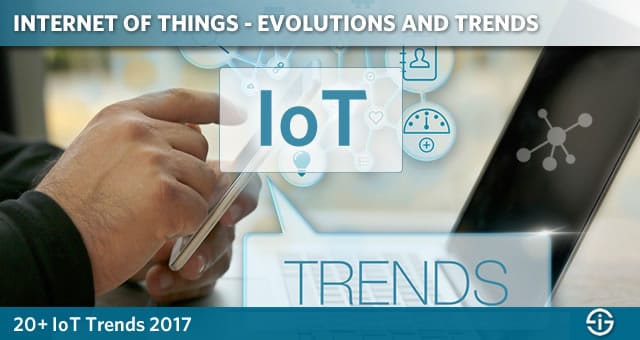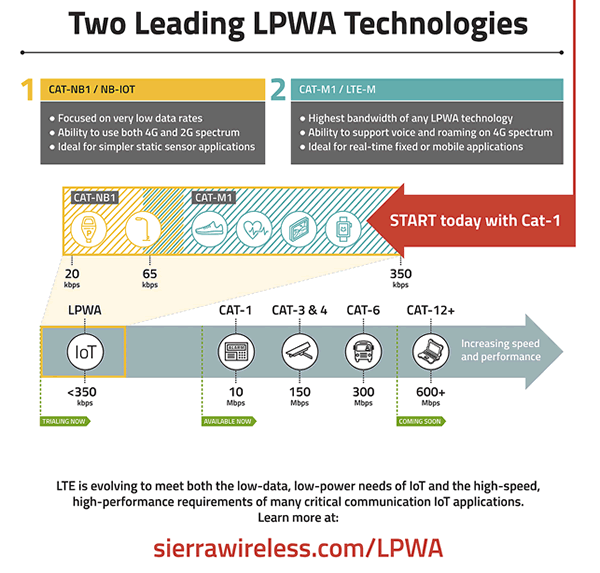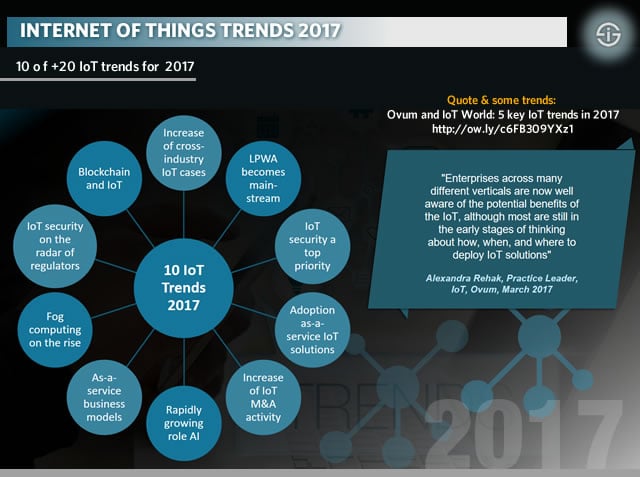A look into some of the main IoT trends for 2017, based on research, observations and different sources.
In March 2017, market research firm Ovum released a list of essential IoT trends for 2017, in collaboration with Internet of Things World. That seemed like a good opportunity to cover some major key IoT trends and predictions too.
We tackle the 5 essential Internet of Things (IoT) trends worth watching in the overall Internet of Things market according to the the organizers of Internet of Things World 2017 and Ovum, add some context and comments and, while we were at it, add over a dozen IoT trends.

The growth of scalable IoT projects and rise of cross-industry IoT deployments
First things first: the 5 IoT trends as reported by the two mentioned parties. Ovum stresses that 2016 was an important year for the Internet of Things but that 2017 is even more important and disruptive, both for the IoT technology players and the many industries where IoT projects are being deployed.
In fact, here is already one IoT trend we can add: based on data regarding the increasing maturity, scalability and deployment of effective IoT projects, beyond the proof of concept stage, this move towards scalable IoT projects is an IoT trend for 2017 for sure. That was our IoT trend number 1.
Today, the majority of ‘significant and disruptive’ IoT trends as Ovum puts it are still mainly happening in industrial settings such as manufacturing (Industry 4.0), transportation and utilities, certainly from an IoT spending perspective. Other IoT projects relate to automotive, retail, consumer IoT, ad hoc IoT-enabled smart city projects and so forth. Moreover, cross-industry IoT use cases and deployments are on the rise and will rise even more in 2017 which is IoT trend number 2. Update: according to June 2017 data by IDC on IoT investments, cross-industry IoT cases will reach $86 billion by the end of 2017. That is more than the second largest industry from an IoT investment perspective (transportation, good for $85 billion).
Taking all this into account and without further ado a look at those five key IoT trends for 2017, as reported by Ovum and Internet of Things World 2017.
IoT connectivity: LPWA technologies become mainstream
The first key IoT trend for 2017, according to Ovum (that’s IoT trend number 3 in our list so far) is the fact that LPWA(N) goes mainstream and is poised to support far more Internet of Things use cases.
The announcement doesn’t mention Low-Power Wide-Area Network (LPWAN) technologies in the unlicensed spectrum such as LoRa and Sigfox, to name just two. Ovum and Internet of Things World 2017 rather point out Narrowband IoT (NB-IoT) and LTE-M (Long Term Evolution for Machines). In other words: Ovum emphasizes the cellular LPWA evolutions or the two standards which have been standardized within the 3GPP (3rd Generation Partnership Project).

Among the main IoT use cases for LPWA which Ovum mentions: smart city applications, smart metering and the connected home.
Non-cellular LPWAN technologies such as LoRa and Sigfox are also used in many smart city projects and virtually all applications where a low-cost, low-bandwidth and long battery life technology is needed, precisely what LPWA, whether it’s cellular or not, is all about.
IoT connectivity: non-cellular LPWAN will prove to be underestimated
Although unlicensed LPWAN technologies today account for a relatively small portion of all IoT cases and investments, we’re pretty sure that, certainly in the increasing number of countries where nationwide coverage exists and in the many large cities and regions where they are planned, they will more than add to the fact that LPWA goes – more – mainstream, with an increasing number of IoT use cases and deployments as a result.
And that brings us to ‘our’ IoT trend number 4. If we look at the many projects where unlicensed spectrum LPWAN is being deployed (e.g. a LoRaWAN testbed in London), the advent of decent new actors in the field (e.g. TrackNet, which raised $7 million), the large companies which are investing in LPWAN players and ecosystems (take a look at the list of the investors in the latest Sigfox investment round) and the technological evolutions whereby multiple connectivity solutions get supported, among other reasons, we believe that the non-cellular LPWA market is underestimated and its growth is yet another IoT trend for 2017 as investments outside the Industrial Internet of Things will grow and companies will roll out low-risk pilots.
If you want an example of the – according to us, underestimated – role of non-cellular LPWA, take a look at what the Airport of Schiphol in The Netherlands is doing.
What is true though is that the non-cellular market evolved first and mainly outside of the US, according to us a reason why it’s underestimated (for now).
IoT security becomes a top IoT priority
This seems like an obvious prediction or, rather IoT trend (number 5), not just given the many security incidents in 2016. If IoT security would not become a core focus for enterprises and providers as Ovum and Internet of Things World put it, we would have a serious issue.
As mentioned previously, and as Ovum also states, security needs to be and will be part of every SERIOUS IoT deployment discussion. This is not just the case for consumer-oriented IoT but also for Industry 4.0 and the Industrial Internet of Things. As we tackled previously, security concerns remain a key showstopper in IIoT, where attacks are on the rise, as well.
Moreover, just security isn’t enough. While security concerns the protection of data and the related technologies, we also need to look at the protection of personal data, what privacy is all about. Blockchain (see below) is poised to play an increasing role here.
IoT regulation becomes a key priority
One of the reasons to do so is the regulatory context. Think about the GDPR and the ePrivacy Regulation, for instance.
In fact, Ovum states that IoT security is coming onto the radar for regulators, which for us is yet another IoT trend as such (that’s number 6 if we counted well). As we mentioned and as we suppose Ovum means, this is also the case outside the scope of EU regulations.
Even if the FTC seems to go for a self-regulation approach we do indeed see and expect regulatory plans and intentions rising. It’s important to note that in the context of regulatory frameworks such as the GDPR and eRegulation, there are specific aspects which need to be tackled regarding the Internet of Things and its technologies.

Analytics and machine learning
Time for IoT trend number 7. According to the announcement of Ovum, Big Data and machine learning will unlock new IoT opportunities.
With this key IoT trend, Ovum in fact summarizes several evolutions. One is the clear shift of the delivery of IoT data analytics to the point of data capture/aggregation or the edge. Indeed: edge computing and fog computing. Once more, we believe that this too is an IoT trend for 2017 as such: the fast rise of edge computing (IoT trend number 8).
A second evolution in the context of Big Data, analytics and machine learning is the rise of new tools for streaming data analytics, Ovum states (IoT trend number 9). Both evolutions fit in a context of the enablement of leveraging IoT data to feed all sorts of artificial intelligence applications, including the feeding of machine-leaning engines.
The growth of as-a-service business models
IoT trend number 10 (five in the list of Ovum and Internet of Things World 2017): the disruptive impact of the IoT will drive the growth of new as-a-service business models.
Most definitely yes. In fact, if you look at a large majority of Industrial Internet of Things cases (look at the case of ABB Robotics, for example, there are plenty more) one of the key digital transformation effects on a business model level is the move towards information-based business models and as-a-service models, making quite some large players develop entirely new services and shifting business models.
We definitely also agree that these ‘innovative business models will continue to evolve in many IoT verticals’ as Ovum predicts, including as-a-service and event-based charging models.
The adoption of as-a-service IoT solutions
We’re adding IoT trend 11 for 2017 here: the growth of as-a-service-models IN the Internet of Things solutions and deployment ‘stack’.
Just as the Internet of Things continues to drive evolutions towards as-a-service model, companies with Internet of Things projects will increasingly use platforms and solutions to enable them in an as-a-service approach. Just one example: Internet of Things security as a service is poised to grow fast.
IoT service providers will increasingly focus on a diversification regarding technologies
The reason: customer needs become more diverse. This is definitely another IoT trend (number 12).
As we see more complex and scalable IoT deployments this is an inevitable evolution. It happens on all levels. Although strictly not a service provider, Cisco for instance already supports several technologies for client projects. The same happens with service providers on other levels. According to Ovum, service providers will also focus more on developer outreach.
The growth and increasing diversity of an IoT channel
We’ve covered all the Ovum trends so let’s look at some more.
IoT trend number 13: an IoT channel will continue to emerge and grow as IT service firms, vendors and distributors seek to diversify revenues and offerings, adding IoT to their portfolios in the scope of their existing strengths in particular areas (e.g. verticals, security, etc.).
This will also happen outside or IT and telecom and among businesses that are not typically part of the IT channel. Examples include marketing firms, offering IoT solutions for which they’ll also need IoT technologies and facility management and smart building companies, convincing their existing channel partners to include IoT solutions in their offerings for existing and new end customers.
Ten more IoT trends and predictions for 2017
We have 13 IoT trends but let’s summarize some more and of course there are even more than those we mention next…
- Although 5G is not ready for prime-time, we’ll see industry consortium efforts grow to push the 5G IoT agenda and market. This will happen within the Fog Consortium Group’s efforts and in new industry initiatives.
- The attention for blockchain and IoT convergence will grow, yet blockchain flaws will need to be fixed as public key is a no-brainer for quantum computers.
- As growth, securtity, analytics and connectivity will require more AI and IBM is boosting its Watson IoT spend and initiatives the battle for AI IoT dominance will increase, mainly for specific verticals.
- M&A activity in the IoT market will increase as providers continue to differentiate their offerings.
- Consumer IoT adoption will grow but regulatory uncertainties in specific regions will surface new security and privacy challenges, among others regarding voice assistants.
- Healthcare payers will step up their efforts to deploy new ways to connect IoT data with healthcare plans.
- Disappointment regarding early smart city IoT deployments will grow while new smart city IoT deployments will increasingly fit in the holistic smart city picture and will be driven by real challenges.
- Retailers will invest less in testing a variety of IoT use cases and focus more on the supply chain and use cases that offer immediate benefits.
- The adoption of wearables will grow faster than expected outside of the consumer wearables context and in verticals such as healthcare and manufacturing.
- IT and OT integration in the Industrial Internet is on the rise but hindred by security concerns, slowing down integration.
- The number of connected devices will grow and there will be more security breaches.
OK, we’re starting to get a bit too obvious so these were, in a nutshell, our +20 IoT trends for 2017 (and beyond).
Top image: Shutterstock – Copyright: Marta Design – All other images are the property of their respective mentioned owners.

